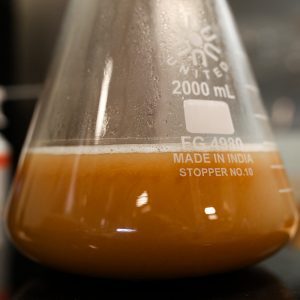
Yeast is the magic ingredient in beer that transforms sugar into carbon dioxide (CO2) and Ethyl Alcohol. There are an enormous variety of yeasts both on the market and in the wild ready to capture, however there is one key difference between yeast that helps us to identify what species it is and how it will behave through fermentation. Simply put, yeast breaks into two categories, Saccharomyces Cerevisiae, and Saccharomyces Pastorianus. The notable difference between these two and how we do differentiate them is that S.Cerevisiae is a top fermenting yeast used primarily for ales and S.Pastorianus is a bottom fermenting yeast, used for the production of lagers. Saccharomyces Cerevisiae can be found in two forms, diploid (two complete sets of chromosomes) and haploid (one complete set of chromosomes). Saccharomyces is a yeast which is a member of the fungus kingdom. It is more commonly found in the diploid form and is oval shaped and sized at less than .01 of a mm. Saccharomcyces Pastornianus tend to be slightly more oval shaped. Saccharomyces are eukaryotic even though they’re a single-celled organism.
Before brewers knew how fermentation took place a variety of practices were put into place, all in hope that it would create the alcoholic product that people know and love. Over time people realised that there was a foaming on top of the original sticky, sugary wort called Krausen which they could scoop off and throw into a new batch and fermentation would begin, a process known as top cropping. Top cropping is still in practice by some breweries today and through this technique humans were able to re-use particular yeast strains.
Further to the types of yeast mentioned above there is Brettanomyces which is a Greek word meaning “British Fungus” is also part of the Saccharomycetaceae family, along with S.Cerevisiae. This yeast is considered to be “wild” and is one that can produce alcohol from sugars of far longer chains that cannot be broken to by the previous two mentioned, as well as regular short chain sugars and is typically found on fruit skins. This yeast was often referred to as spoilage yeast that would ruin many beers and wines, however it is becoming more common in today’s brewing as brewers look to experiment and produce different flavours. Brettanomyces have been an integral part of brewing in European beers for centuries, and when people were first top cropping all three of these yeasts, along with a plethora of bacteria would have been found in the fermented product. This beer would have tasted very little like today's beer found on the shelves. Looking closely at Brettanomyces they’re typically a stretched out oval shape but can range to a more circular shape and is a non-spore forming genus of yeast in the Saccharomycetaceae family. Dekkera is another name for Brettanomyces but is the spore forming version. Typical characters produced by Brettanomyces that people talk of, especially in wine making are band-aid, cheese, horse blanket and hay. Although there may be times where these terms are correct, when Brettanomyces are used correctly they can produce a great plethora of flavours ranging from the already mentioned horse blanket and hay found in some Belgian beers, to stone fruit, lemon zest and white grape like aromas.
Alongside the wild yeast and Brettanomyces there are bacterias that are used in brewing. More common than others, Lactobacillus is now widely used for producing beers that are slightly tart, all the way to abrasively sour. Lactobacillus is a lactic acid producing bacteria that is shaped like a rod and is a Prokaryotic cell. Lactobacillus can work in the presence of oxygen or without oxygen and thrives at higher temperatures than yeast, between 35 – 45c in some cases.
Pediococcus is another lactic acid producing bacteria that is also widely used. This bacteria tends to produce large amounts of diacetyl (buttery popcorn) and so it is always recommended that it is used in conjunction with Brettanomyces as the yeast will over time clean the diacetyl up. Pediococcus can also go through a stage where the beer becomes “ropey” or snot-like. On some occasions if a sour beer is purchased the beer may pour out extremely thick and viscous which is a sign that refermentation has happened and the Pediococcus is at play. Once again we can thank the Brettanomyces as it eventually cleans this mess up.
Yeast and bacteria are used in the last stage of brewing after the boil is finished and cooled. Both are quite specific living ingredients that need to be treated just right to give us what we want. Yeast and bacteria will ferment in a range of temperatures; however slight temperature changes often mean noticeable changes when drinking the beer. Some yeasts perform well in colder temperatures such as S.Pastorianus which is often used at temperatures around 12c whilst S.Cerevisiae is used typically between 18-24c depending on the strain. As mentioned earlier, the bacteria Lactobacillus can ferment at far higher temperatures and will thrive, replicating and producing more cells. Brettanomyces can also ferment quite well up to 28c, however it is also happy fermenting cooler.
Keg King stocks a wide range of yeasts and cultures for purchase in Australia. Dry yeasts have a much longer shelf life than liquid yeast and are generally better value in terms of the cell count. Liquid cultures offer a much wider range of species but the viability (effective cell count) decreases quicker than dry yeasts. All our yeast and cultures are stored refrigerated and we recommend shipping liquid yeasts express with ice packs to maintain their viability.
